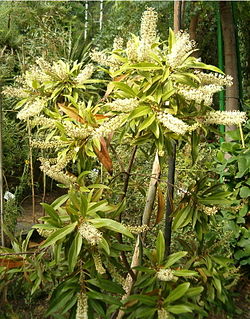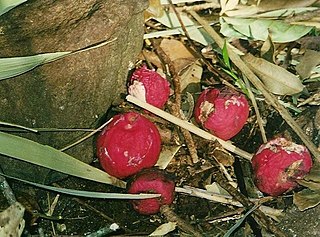
Myrtaceae or the myrtle family is a family of dicotyledonous plants placed within the order Myrtales. Myrtle, pōhutukawa, bay rum tree, clove, guava, acca (feijoa), allspice, and eucalyptus are some notable members of this group. All species are woody, contain essential oils, and have flower parts in multiples of four or five. The leaves are evergreen, alternate to mostly opposite, simple, and usually entire. The flowers have a base number of five petals, though in several genera the petals are minute or absent. The stamens are usually very conspicuous, brightly coloured and numerous.

Syzygium is a genus of flowering plants that belongs to the myrtle family, Myrtaceae. The genus comprises about 1200 species, and has a native range that extends from Africa and Madagascar through southern Asia east through the Pacific. Its highest levels of diversity occur from Malaysia to northeastern Australia, where many species are very poorly known and many more have not been described taxonomically.

Eidothea is a genus of two species of rainforest trees in New South Wales and Queensland, in eastern Australia, constituting part of the plant family Proteaceae. The plant family Proteaceae was named after the shape-shifting god Proteus of Greek mythology. The genus name Eidothea refers to one of the three daughters of Proteus.

Buckinghamia is a genus of only two known species of trees, belonging to the plant family Proteaceae. They are endemic to the rainforests of the wet tropics region of north eastern Queensland, Australia. The ivory curl flower, B. celsissima, is the well known, popular and widely cultivated species in gardens and parks, in eastern and southern mainland Australia, and additionally as street trees north from about Brisbane. The second species, B. ferruginiflora, was only recently described in 1988.

Xanthostemon is a genus of trees and shrubs, constituting part of the myrtle plant family Myrtaceae. This genus was first described in 1857 by German–Australian botanist Ferdinand von Mueller. According to different official sources between 46 and 51 species are known to science. They grow naturally in New Caledonia, Australia, the Solomon Islands and Malesia, including the Philippines, New Guinea and Indonesia. The genera Pleurocalyptus and Purpureostemon from New Caledonia are morphologically close to Xanthostemon.
Thaleropia is a genus of flowering plants in the family Myrtaceae first described as a genus in 1993. It is native to Queensland and Papuasia.

Syzygium ingens, commonly known as red apple, is a species of flowering plant that is endemic to eastern Australia. It is a medium-sized to tall rainforest tree with narrow elliptic to oblong leaves and panicles of white flowers on the ends of branchlets, followed by spherical red berries.
Bernard Hyland, known as Bernie Hyland, has a long career as an Australian botanist.
Ristantia is a group of plants in the family Myrtaceae described as a genus in 1982. The entire genus is endemic to the State of Queensland in Australia.
- Ristantia gouldiiPeter G. Wilson & B. Hyland - a tree species listed as vulnerable
- Ristantia pachysperma(F.Muell. & F.M.Bailey) Peter G.Wilson & J.T.Waterh.
- Ristantia waterhouseiPeter G.Wilson & B.Hyland
Hicksbeachia pilosa is a small tree in the family Proteaceae. This rare species is endemic to the rainforests of the wet tropics region of northeastern Queensland, Australia. It was first described in 1988 by Australian botanist Peter H. Weston, after a collection by Garry Sankowsky and Peter Hind in 1986 at Bobbin Bobbin Falls in North Queensland. Its specific name is the Latin adjective pilosus "hairy".
Neorites is a genus of a sole described species of tall tree in the family Proteaceae. The species Neorites kevedianus, commonly called fishtail oak or fishtail silky oak, is endemic to the wet tropics rainforests of north eastern Queensland, Australia.
Stockwellia is a monotypic genus in the flowering plant family Myrtaceae. The sole species in the genus, Stockwellia quadrifida, is endemic to Queensland.
Hollandaea is a small genus of plants in the family Proteaceae containing four species of Australian rainforest trees. All four species are endemic to restricted areas of the Wet Tropics of northeast Queensland.

Placospermum is a genus of a single species of large trees, constituting part of the plant family Proteaceae. The species Placospermum coriaceum is endemic to the rainforests of the wet tropics region of northeastern Queensland, Australia. Common names include rose silky oak and plate-seeded oak.

Carnarvonia is a flowering plant genus of a single species, commonly named red oak or red silky oak and constituting part of the plant family Proteaceae. The single species named Carnarvonia araliifolia grows to large trees of 30 m (100 ft) or more. They grow naturally only (endemic) to the Wet Tropics rainforests region of north-eastern Queensland, Australia. The species has two described varieties, C. araliifolia var. araliifolia and C. araliifolia var. montana, and the common names are used for both.
Barongia is a genus of flowering plants in the myrtle family, Myrtaceae first described as a genus in 1988. It contains only one known species, Barongia lophandra, endemic to the Cook region of Queensland, Australia.
Neofabricia is a genus of shrubs and small trees in the family Myrtaceae, first described as a genus in 1788, with the name Fabricia. This, however, was an illegitimate homonym, in other words, someone had already used the name to refer to a very different plant. Therefore, this group in the Myrtaceae was renamed Neofabricia. The entire genus is endemic to Queensland.
- Neofabricia mjoebergii(Cheel) Joy Thomps.
- Neofabricia myrtifolia(Gaertn.) Joy Thomps.
- Neofabricia sericisepalaJ.R.Clarkson & Joy Thomps.
Sphaerantia is a group of flowering plants in the family Myrtaceae, described as a genus in 1988. The entire genus is endemic to the northern part of the State of Queensland in Australia.
- Sphaerantia chartaceaPeter G.Wilson & B.Hyland
- Sphaerantia discolorPeter G.Wilson & B.Hyland
Corymbia hylandii, commonly known as Hyland's bloodwood, is a species of small tree that is endemic to part of the Cape York Peninsula. It has rough, tessellated bark on the trunk and branches, lance-shaped adult leaves, flower buds in groups of seven, creamy white flowers and urn-shaped fruit.
Xanthostemon formosus is a species of tree in the myrtle family Myrtaceae that is endemic to north-eastern Queensland, Australia.







